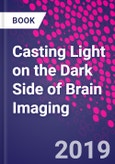Casting Light on The Dark Side of Brain Imaging tackles these questions through a critical and constructive lens-separating fruitful science from misleading neuro-babble. In a breezy writing style accessible to a wide readership, experts from across the brain sciences offer their uncensored thoughts to help advance brain research and debunk the craze for reductionist, headline-grabbing neuroscience.
This collection of short, enlightening essays is suitable for anyone interested in brain science, from students to professionals. Together, we take a hard look at the science behind brain imaging and outline why this technique remains promising despite its seldom-discussed shortcomings.
Please Note: This is an On Demand product, delivery may take up to 11 working days after payment has been received.
Table of Contents
Section I: Imaging bains: What for? 1. Can neuroimaging reveal how the brain thinks? 2. Is addiction a brain disease? 3. How brain imaging takes psychiatry for a ride 4. Brain-computer interfaces for communication in paralysis 5. Neurohype and the law: A cautionary tale 6. The brain in the classroom: The mindless appeal of neuroeducation
Section II: What are we measuring? 7. Brain waves: How to decipher the cacophony 8. On the relationship between functional MRI signals and neuronal activity 9. MRI artifacts in psychiatry: Head motion, breathing, and other systematic confounds 10. When the brain lies: Body posture alters neural activity
Section III: The devil's in the details 11. The replication challenge: Is brain imaging next? 12. Power and design considerations in imaging research 13. Why neuroimaging can't diagnose autism
Section IV: Neuroimaging: Holy Grail or false prophet? 14. From mind to brain: The challenge of neuro-reductionism 15. The power of belief in the magic of neuroscience 16. Neuroplacebos: When healing is a no-brainer 17. Brain imaging and artificial intelligence
Section V: Can we train the brain better? 18. Noninvasive brain stimulation: When the hype transcends the evidence 19. Neurofeedback: An inside perspective 20. The (dis)enchantment of brain-training games 21. What's wrong with "the mindful brain"? Moving past a neurocentric view of meditation 22. "Backed by neuroscience": How brain imaging sells
Section VI: What next? 23. From regions to networks: Neuroimaging approaches to mapping brain organization 24. Whole-brain modeling of neuroimaging data: Moving beyond correlation to causation 25. Connecting networks to neurons 26. High field magnetic resonance imaging








